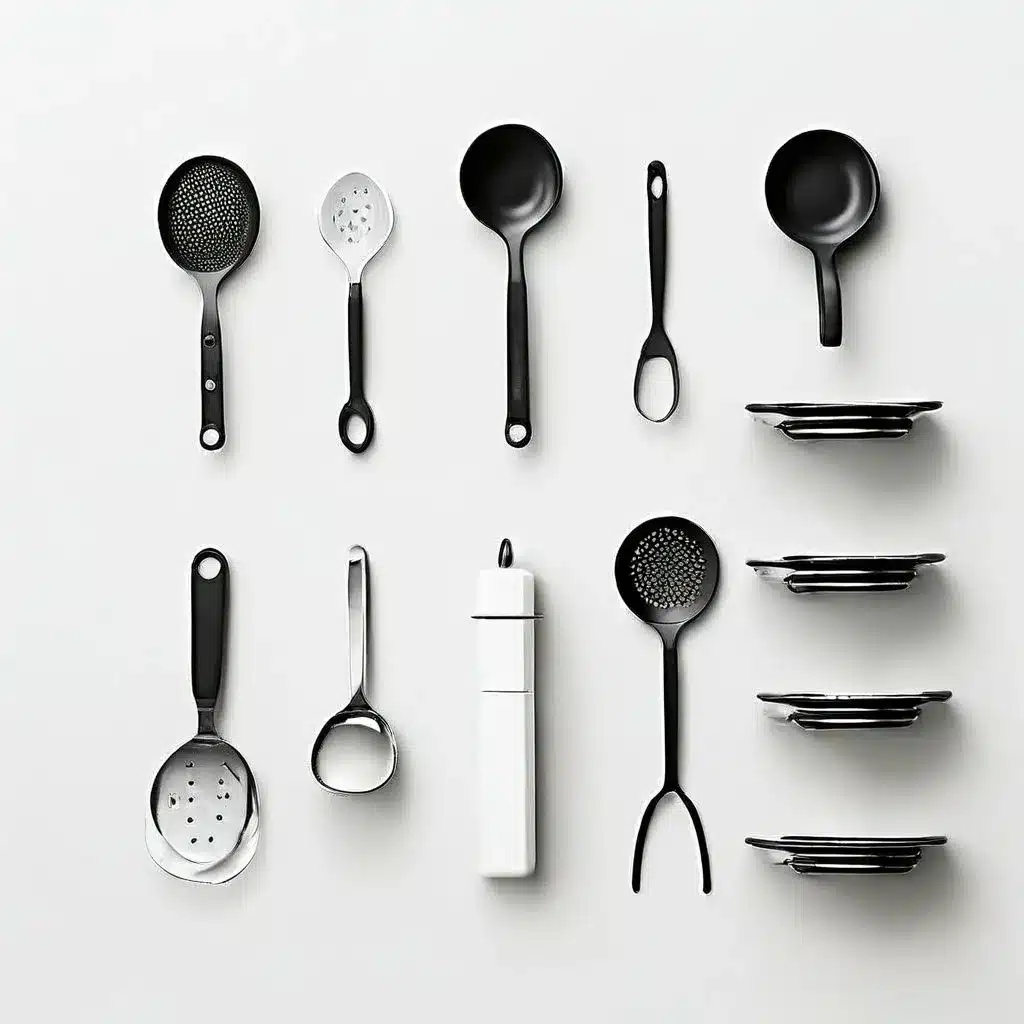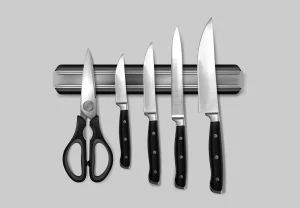Cookware is made from many different types of materials, each of which brings its unique advantages and challenges to our culinary experiences. From stainless steel and silicone to wood, glass and plastic, the range of materials such as nylon, Teflon and even ceramic evolves with our culinary needs.
Certain criteria are essential when choosing a material, such as: durability, maintenance and safety, including aspects such as microwave and dishwasher safe options, as well as heat conduction qualities.
We already did an article on the best materials for cookware. Now we will talk more in depth about all the types of materials with each of their particularities.
Stainless Steel
Stainless steel stands out in the kitchen for its exceptional durability and aesthetic appeal. Here’s why it’s a favorite among both home cooks and professional chefs:
Durability and Maintenance
- High Resistance: Stainless steel cookware is renowned for its ability to resist warping, bending, and rusting. This makes it a durable choice that can withstand the rigors of everyday cooking.
- Easy to Clean: The nonporous surface of stainless steel means it doesn’t harbor bacteria or germs, making it simple to clean and maintain. A quick wipe with soapy water is often enough to keep it looking new.
- Dishwasher Safe: Unlike many other materials, stainless steel utensils can be conveniently cleaned in a dishwasher, saving time and effort.
Cooking Performance
- Even Heat Distribution: Although stainless steel itself is not the best conductor of heat, high-quality pieces are typically constructed with a core of aluminum or copper, which ensures heat is distributed evenly across the cooking surface.
- Non-Reactive Surface: Stainless steel does not react with acidic or alkaline foods, which means it won’t alter flavors or release harmful substances into your meals.
Health and Safety
- Non-Toxic: Free from harmful toxins, stainless steel is safe for cooking at high temperatures. It’s an excellent alternative to cookware with chemical non-stick coatings that can degrade over time.
- Flavor Preservation: It does not impart any metallic taste to food, preserving the natural flavors of the ingredients.
Aesthetic and Versatility
- Elegant Finish: Stainless steel cookware often features a polished, shiny appearance that can enhance the look of any kitchen.
- Versatility: Suitable for use on all types of cooktops, including induction, gas, and electric, stainless steel is versatile enough for any cooking method.
Environmental Impact
- Recyclability: As an eco-friendly material, stainless steel is 100% recyclable, contributing to environmental sustainability. Many stainless steel products are made using recycled materials, reducing the need for new resources.
Recommendations for Use
- Suitable Utensils: To avoid scratching the surface, it’s advisable to use utensils made of wood, silicone, or plastic. Avoid metal or abrasive materials to maintain the integrity of the cookware.
By choosing stainless steel, you not only opt for a material that is durable and easy to maintain but also make a choice that is safe for your health and good for the environment.
Silicone
Silicone stands out as a versatile and safe option in the realm of kitchen utensils. Recognized for its heat resistance and flexibility, silicone is a synthetic polymer that has found extensive use across various industries, including kitchenware. Here’s a closer look at why silicone is a preferred choice for modern kitchens:
Key Attributes
- Heat Resistance: Silicone utensils can withstand temperatures up to 250°C, making them ideal for high-heat cooking.
- Flexibility: The inherent flexibility of silicone makes it perfect for scraping and scooping every last bit of food from bowls and pans.
- Non-Toxic and Easy to Clean: Being non-toxic and dishwasher safe, silicone utensils are easy to maintain and safe for everyday cooking.
Safety and Durability
- FDA Approval: Since 1979, the FDA has recognized food-grade silicone as safe (GRAS) for culinary uses.
- Durability: Silicone does not wear down easily and is resistant to damage from repeated use.
Comparison with Other Materials
- Versus Nylon: Unlike nylon, which has a lower melting point and can release chemicals at high temperatures, silicone remains stable and safe.
- Environmental Consideration: Although silicone is not biodegradable, it is recyclable under specific conditions, unlike many plastic utensils.
Recommended Brands
- Some top brands offering high-quality silicone kitchen utensils include La Gourmet, Le Creuset, and IKEA Malaysia, known for their commitment to safety and quality.
Considerations
- Quality Variance: It’s crucial to select 100% pure food-grade silicone, as lower quality options might contain harmful plastic fillers.
- Longevity Issues: While durable, thin silicone utensils can soften over time, which might affect their performance with delicate tasks like flipping.
Silicone kitchen utensils, with their non-stick surface and heat-resistant properties, are excellent for tasks such as sautéing or cooking sticky foods like eggs. Their safety profile, coupled with ease of maintenance, makes them an invaluable addition to any kitchen.
Wood
Wooden kitchen utensils are a staple in many homes, revered not only for their classic aesthetic but also for their functionality and safety. Here’s an in-depth look at why wood remains a top choice for culinary tools:
Traditional Appeal and Safety
- Non-Reactive: Wooden utensils do not react with acidic foods, ensuring that flavors remain pure and untainted.
- Naturally Antibacterial: The porous nature of wood traps bacteria, which are then naturally eliminated over time.
- No Chemical Leaching: Unlike some plastics and non-stick coatings, wood does not release harmful chemicals into food.
Durability and Maintenance
- Long-Lasting: When properly cared for, wooden utensils can serve your kitchen needs for years, becoming smoother and more attractive with age.
- Care Tips: Regular oiling and hand washing are recommended to maintain their appearance and functionality.
Environmental Impact
- Sustainability: Wood is a renewable resource, making wooden utensils an eco-friendly choice for the environmentally conscious cook.
- Biodegradable: At the end of their life cycle, wooden utensils can be composted, reducing waste.
Versatility in Use
- Heat Resistant: Unlike metal, wood does not conduct heat, making it safe for use in cooking without risk of burns.
- Gentle on Cookware: Wood is less likely to scratch delicate surfaces compared to metal utensils, preserving the life of your cookware.
Wooden kitchen utensils not only bring a touch of natural elegance to your culinary space but also offer practical benefits that make cooking safer and more enjoyable.
Glass
Key Attributes and Uses
- Non-Toxic and Eco-Friendly: Glass cookware is celebrated for its non-toxic nature and minimal environmental impact, making it a preferred choice for health-conscious consumers.
- Heat-Tempered for Durability: Brands like Pyrex are renowned for their heat-tempered glass, which can withstand sudden temperature changes, ideal for baking and food storage.
- Versatility: Glass is suitable for a variety of cooking methods, including stews, soups, and baking, thanks to its ability to handle gentle, consistent cooking temperatures.
Limitations
- Uneven Heat Distribution: Glass does not conduct heat as uniformly as metals, which can be a drawback for recipes requiring a crisp finish.
- Not Induction Compatible: Due to its non-conductive nature, glass cannot be used on induction stovetops.
Care and Maintenance
- Thermal Shock Sensitivity: Handle glass cookware with care to avoid rapid temperature changes which can lead to cracking or shattering.
- Cleaning Ease: Its non-porous surface makes it easy to clean, maintaining hygiene and aesthetic appeal.
Environmental and Health Benefits
- Recyclability: Glass is fully recyclable, contributing to its eco-friendly status.
- Chemical Safety: It does not leach chemicals into food, ensuring that your meals remain safe and uncontaminated.
Aesthetic and Practical Benefits
- Transparency: The clear nature of glass allows for easy monitoring of food as it cooks.
- Serving Convenience: Its attractive appearance makes it suitable for direct table service, enhancing the dining experience.
Plastic and Nylon
Overview of Plastic and Nylon Utensils
Plastic and nylon kitchen tools are common due to their affordability and practicality. However, it’s crucial to understand their limitations and safety concerns.
Key Considerations
- Temperature Tolerance:
- Nylon can withstand higher temperatures compared to regular plastic but is still less heat-resistant than silicone or metal.
- It is not suitable for high-heat environments as it can melt or release harmful chemicals.
- Durability and Safety Concerns:
- Nylon utensils are generally sturdier than silicone and can be thinner, making them ideal for tasks like flipping pancakes.
- Plastic utensils, especially if they are of lower quality, can chip and shred, potentially introducing toxins into food.
- Health Risks:
- Certain plastics can contain harmful chemicals such as phthalates, BPA, and lead, which have been linked to health issues including hormone disruption and cancer.
- Nylon products, particularly those from unreliable sources, might contain diaminodiphenylmethane (DDM), which poses additional health risks.
- Environmental Impact:
- While nylon is more durable, both plastics and nylons are concerning from an environmental standpoint due to issues with biodegradability and recycling challenges.
Usage Tips
- Choosing Utensils: Opt for high-quality nylon to avoid the risks associated with cheaper plastics. Always check for any certifications that ensure safety from harmful chemicals.
- Care and Replacement: Do not expose nylon utensils to high temperatures and replace them if you notice any signs of cracking or breaking down to prevent bacterial growth and chemical leaching.
Summary Table: Plastic vs. Nylon Utensils
| Feature | Plastic | Nylon |
| Heat Resistance | Low (can melt or warp at lower temperatures) | Higher than plastic, but lower than metal |
| Durability | Prone to chipping and breaking | More durable, can become brittle with high heat |
| Health Safety | Often contains harmful chemicals | Safer than low-quality plastic but check for harmful additives |
| Environmental Impact | Less eco-friendly, hard to recycle | Slightly better, but still has recycling issues |
| Cost | Generally cheaper | Slightly more expensive but offers better durability and safety |
By understanding these aspects, you can make more informed choices about which utensils to use in your kitchen to ensure both safety and effectiveness in your cooking practices.
Ceramic
Ceramic cookware, recognized for its non-toxic and eco-friendly properties, offers a unique blend of aesthetic appeal and functional benefits. Here’s how ceramic stands out in the kitchen:
Key Attributes
- Non-Reactive Surface: Ideal for cooking acidic foods without altering flavors.
- Heat Management: Performs best at moderate temperatures, perfect for slow cooking and simmering.
Performance and Maintenance
- Non-Stick Coating: Simplifies cooking of sticky foods like eggs without extra oil.
- Easy Cleanup: The smooth surface allows for quick washing.
- Induction Compatibility: Works on all cooktops, including induction, making it a versatile choice.
Health and Sustainability
- Safe Cooking: Free from harmful chemicals like PFOA and PTFE, ensuring healthier meal preparation.
- Durability: Though prone to chipping, high-quality ceramic can last longer, reducing replacement needs.
Care Tips
- Gentle Use: Avoid metal utensils to prevent surface damage.
- Temperature Caution: Gradual heating is recommended to avoid thermal shock.
- Special Handling: Hand-washing is advised to maintain the integrity of the surface.
Practical Considerations
- Cost Factor: Generally more expensive due to its beneficial features.
- Learning Curve: Requires some adjustments in cooking habits for optimal use.
This blend of features makes ceramic an appealing choice for those prioritizing health and style in their kitchen tools.
Conclusion
The choice of cookware is more than mere functionality: it is a reflection of your tastes, individual culinary practices, health consciousness and environmental responsibility.
Whether you opt for the enduring elegance of stainless steel, the eco-friendly charm of wood, the versatile innovation of silicone or the health benefits of ceramic, each material has the potential to profoundly influence the quality and safety of your culinary endeavors.
Choose the one you like best!





